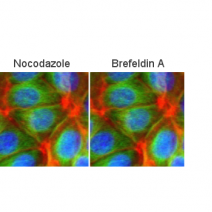Revealing invisible cell phenotypes with conditional generative modeling
A. Lamiable, T. Champetier, F. Leonardi, E. Cohen, P. Sommer, D. Hardy, N. Argy, A. Massougbodji, E. Del Nery, G. Cottrell, Y-J. Kwon, A. Genovesio
Authors
Alexis Lamiable, Tiphaine Champetier, Francesco Leonardi, Ethan Cohen, Peter Sommer, David Hardy, Nicolas Argy, Achille Massougbodji, Elaine Del Nery, Gilles Cottrell, Yong-Jun Kwon & Auguste Genovesio
Abstract
Biological sciences, drug discovery and medicine rely heavily on cell phenotype perturbation and microscope observation. However, most cellular phenotypic changes are subtle and thus hidden from us by natural cell variability : two cells in the same condition already look different. In this study, we show that conditional generative models can be used to transform an image of cells from any one condition to another, thus canceling cell variability. We visually and quantitatively validate that the principle of synthetic cell perturbation works on discernible cases. We then illustrate its effectiveness in displaying otherwise invisible cell phenotypes triggered by blood cells under parasite infection, or by the presence of a disease-causing pathological mutation in differentiated neurons derived from iPSCs, or by low concentration drug treatments. The proposed approach, easy to use and robust, opens the door to more accessible discovery of biological and disease biomarkers.
Nat Commun. 2023 Oct 11 ;14(1):6386. doi : 10.1038/s41467-023-42124-6


